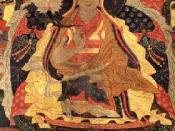In 1949, Tibet was a peaceful, independent country situated in the Himalayan Mountains. China, its neighbour to the North, however, was under a major transition as its civil war ended. Under the leadership of Mao Zhe Dong, China became a Communist country. One of the first proclamations of this new government was to announce to the world that there was only "One China", and that Tibet was lying within its borders. Without an army that could defend the country from invasion , the Tibetan government looked to the global community for help. America was the leading superpower at this time and its foreign policy, including the Truman Doctrine was focused on containing the spread of Communism creating hope for the Tibetans. Harry Truman had developed this doctrine to convince Congress to give money to prevent Greece and Turkey from being dominated by the Communists, but at the same time he also committed America to the moral role as the defender of free people worldwide who opposed Communism.
Under the Truman Doctrine the United States of America was obligated to aid Tibet in its attempt to maintain independence from China and by not living up to its obligation lost credibility as a world leader committed to defending free people.
In 1945, America emerged as a victor from World War II and was interested in reorganizing the world in such a way that would ensure their security. Their main concern was to prevent the other major victor, the Soviet Union, from spreading the communist ideology. Communism was a threat to America and its economy because it denounced capitalism and its pursuit of material wealth. The demand to restrain Communism required America to shift out of the ideology of isolationism proposed in the Monroe Doctrine and into one of intervention. This shift required...


